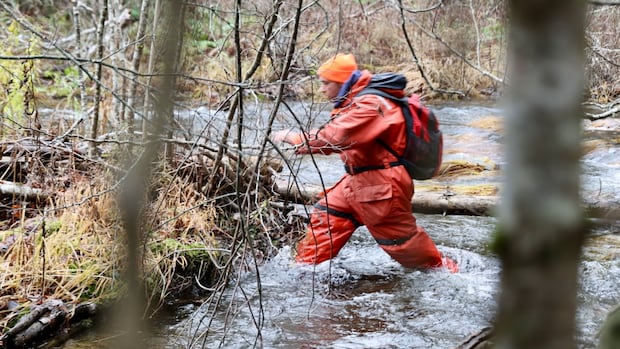Nova Scotia·NewAfter a grueling day wading through rushing river waters and climbing through dense woods, some family members of two missing Nova Scotia children were left disappointed their last-ditch search for the siblings before the snow flies did not result in an obvious breakthrough. Jack and Lilly Sullivan were reported missing from Lansdowne, N.S., on May 2Listen to this articleEstimated 6 minutesThe audio version of this article is generated by text-to-speech, a technology based on artificial intelligence.A volunteer wades through water during the search for Jack and Lilly Sullivan on Saturday, Nov. 16, 2025. (Jeorge Sadi/CBC)After a grueling day wading through rushing river waters and climbing through dense woods, some family members of two missing Nova Scotia children were left disappointed that their last-ditch search for the siblings before the snow flies did not result in an obvious breakthrough.A few items of interest were discovered during the search for Lilly Sullivan, 6, and Jack Sullivan, 5, on Saturday in Lansdowne, N.S., but RCMP say none of the items hold any relevance to the disappearance of the two children.About 30 volunteers descended upon the sparsely populated community to scour for any signs of the siblings, who vanished more than six months ago. Many had hoped they would find the children.“That’s not what happened today,” said Angeline Maloney-Arsenault, a childhood friend of the children’s mother. “I do feel that we have more questions, especially with finding things throughout the woods.“I do feel disappointed.”Cheryl Robinson, left, is Lilly and Jack Sullivan’s aunt and Angeline Maloney-Arsenault is a childhood friend of their mother. Robinson led a group of searchers on Saturday. (Jeorge Sadi/CBC)Lilly and Jack were reported missing on May 2, when their mother, Malehya Brooks-Murray, called 911 and reported they had wandered away from their home, which borders thick woods.Their disappearance sparked an extensive grid search that spanned 8.5 square kilometres of mostly dense woods and involved about 160 ground search and rescue volunteers, service dogs, drones and helicopters.RCMP cadaver dogs also searched a total of 40 kilometres over three days in late September.Saturday’s search was led by the Ontario-based non-profit Please Bring Me Home. Volunteers —many of them family and friends of the children — gathered at the Union Centre Community Hall and were split into six groups, destined to cover roughly five kilometres each along the banks of the Middle River of Pictou.Nick Oldrieve, executive director of the organization, said the search was to focus on waterways that may have moved or concealed clues during earlier searches.“Enough time has passed now that revisiting these waterways … it’s a high probability that they are there, if the theory is that they wandered off,” said Oldrieve, who drove 18 hours from his home in Ontario to manage the search. Nick Oldrieve is the executive director of Please Bring Me Home, a non-profit organization based in Ontario. Oldrieve says the search was funded through donations. (Jeorge Sadi/CBC)His organization also ran a search on Friday in the Springhill area for Jessie Morrissey, who has been missing since February 2022.Oldrieve said Please Bring Me Home has helped locate more than 50 missing people since 2018. Last year, they located the remains of Eric Spencer in Honey Harbour, Ont., who had been missing for six years.On Saturday, crews were faced with extremely challenging conditions. At times, volunteers were forced to wade through waist-deep water, climb across downed trees and push back thick brush, all while keeping their eyes peeled for clues.Volunteer searchers were met with challenging conditions on Saturday. (Aly Thomson/CBC)Those efforts resulted in a few items of interest, however, RCMP said in an email Sunday that investigators reviewed the materials and found they “hold no relevance.”Volunteers came upon a child’s black T-shirt with a blue design. Oldreive said a photo of a T-shirt was sent to RCMP, who then sent it to the children’s mother, but she didn’t recognize it.A geocaching kit was also uncovered. Geocaching involves hiding a container of items, such as papers and trinkets, and posting the GPS coordinates to an app for other people to find. The kit had a log book containing the name of the children’s stepfather. It read: ”Daniel Martell, May 3, 2014, left a 2012 quarter.” Martell and his family have lived in the area for decades.A blue blanket was also found, and a child’s bicycle. Searchers also visited the area where a drone detected two heat sources around 11:30 p.m. on May 2. In an email last week, RCMP said the signatures were investigated on foot by an RCMP officer and determined they were not relevant. It’s believed they were emitted by a bear in the area.A volunteer searcher logs coordinates where two heat signatures were detected by a drone late in the evening on May 2, the day Jack and Lilly Sullivan went missing. (Angela MacIvor/CBC)One group also came across bones that were wrapped in a blanket, but Oldrieve said the group’s anthropologist determined they were animal bones after being sent a photo.Oldrieve said Please Bring Me Home will compile a report to send to the RCMP, which will include photos of the items and their GPS coordinates.One group endured a tense interaction with a local property owner as they were walking along the river. Standing at the top of a steep bank, the man shouted for the searchers to leave and told them he had dangerous animals — two rams.Permission had not been obtained from each individual property owner along the river where the search was happening. Oldrieve had told the group to call him if they came across someone who did not want them there. He said he spoke briefly with that property owner later that day.The case has sparked tensions in the community and between members of Jack and Lilly’s family. The mystery has garnered international media attention and led to finger-pointing on all sides.The normally sleepy hamlet of Lansdowne has seen its fair share of searchers, police, journalists and casual observers since the children went missing.Belynda Gray is Jack and Lilly Sullivan’s paternal grandmother. (Jeorge Sadi/CBC)RCMP continue to say the case is being investigated under the Missing Persons Act and is not believed to be criminal.The Mounties say the Northeast Nova major crime unit has been following up on information that has been gleaned from forensic testing, more than 860 tips and 8,060 video files. A slew of units are working on the case and have been since May.But Belynda Gray, the children’s paternal grandmother, is getting impatient.Gray said she was “a little apprehensive” after Saturday’s search. Through tears, Gray said she still believes the children are in the woods.“I know they’re out there,” said Gray, whose daughter was helping with the search.Oldrieve said based on what he’s now seen on the ground — including the many orange and pink ribbons marking off areas that were already searched and after speaking with authorities, family and locals — he’s having a hard time believing they wandered into the woods.“I just find it more unlikely today by the minute,” he said.Nevertheless, Oldrieve confirmed on Sunday that accredited cadaver dogs, trained to detect the scent of human remains, would return to Lansdowne this week to conduct a search.Cheryl Robinson, a family friend of Lilly and Jack, led a team of searchers on Saturday. Despite feeling disappointed by the results, she still has hope.“We definitely won’t stop looking for them.”MORE TOP STORIES ABOUT THE AUTHORAly Thomson is an award-winning journalist based in Halifax who loves helping the people of her home province tell their stories. She is particularly interested in issues surrounding women’s health, justice, education and the entertainment industry. You can email her with tips and feedback at aly.thomson@cbc.ca.
Items discovered during volunteer search for missing N.S. children not relevant: RCMP












